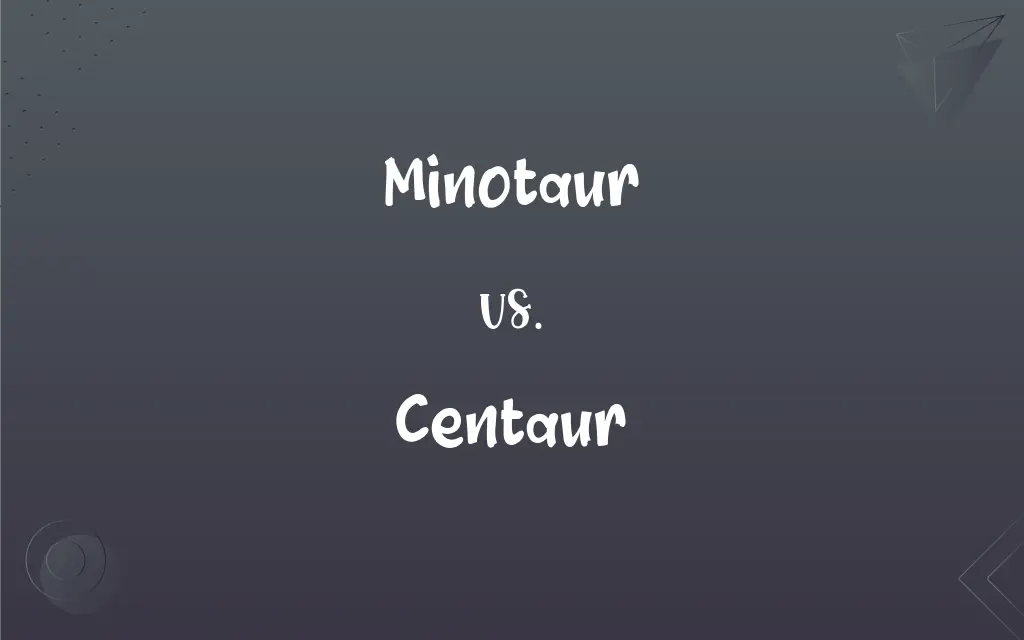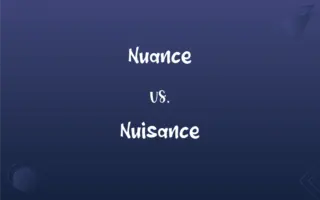Minotaur vs. Centaur: What's the Difference?
Edited by Aimie Carlson || By Janet White || Updated on October 6, 2023
Minotaur has a human body and bull's head; Centaur is half-human, half-horse, with a human upper body affixed to a horse's torso.

Key Differences
Minotaur, stemming from Greek mythology, exhibits a unique blend of human and bull, embodying a creature with a human body and a bull's head. Centaur, on the other hand, emerges from a different mythological space, presenting a fusion of human and horse, with a human upper body extending where a horse's neck and head should be. The Minotaur carries a narrative that revolves around entrapment and isolation, associated with the labyrinth in Crete and a terrifying threat to those within its walls. Conversely, Centaurs carry a narrative that encapsulates both wisdom and chaotic tendencies, being both mentors (like Chiron) and wild, disruptive forces in various mythological tales.
In the context of cultural symbolism, the Minotaur often stands as a symbol of oppression, danger, or formidable, concealed threat given its dwelling and role in the labyrinth. Centaurs embody a dichotomy of civilization and wildness, representing the dual nature of humanity, with its rational and beastly sides. Where the Minotaur is largely viewed through a lens of hostility and fear, due to its lore of consuming human sacrifices, Centaurs are perceived in a more varied light, being both revered teachers and unruly beings in diverse stories.
Artistically, representations of the Minotaur might evoke themes of confinement, fear, and the hidden monstrous within humanity. The Centaur, alternatively, might explore themes of conflict between our civilized and barbaric natures, or the merging of two worlds or states of being. Furthermore, the Minotaur's story, steeped in tragedy, cruelty, and a stark binary of humanity versus beast, provides a singular path of interpretation and metaphor. In contrast, the Centaur, with its complex, varied portrayals across mythologies, offers a broader, more multi-faceted palette for interpretation and symbolic representation.
Comparison Chart
Physical Appearance
Human body with a bull’s head
Human upper body, horse lower body
Symbolism
Often symbolizes oppression or concealed threat
Represents duality of human nature
ADVERTISEMENT
Mythological Origin
Greek, specifically linked to Crete’s Labyrinth
Greek, varied stories and roles
Interaction with Humans
Generally hostile, viewed as a threat
Varied, can be mentors or threats
Common Narrative Role
Typically a creature to be defeated or avoided
Can be mentors, foes, or wild beings
Minotaur and Centaur Definitions
Minotaur
Minotaur is a creature with a human body and bull's head.
The Minotaur lurked in the labyrinth, waiting for its next victim.
Centaur
Centaur interacts with humans, sometimes offering guidance.
In mythology, a Centaur often appears to guide or challenge heroes.
ADVERTISEMENT
Minotaur
Minotaur symbolizes a concealed, formidable threat.
His power was like the Minotaur, hidden yet ever-present.
Centaur
Centaur possesses a human upper body and the lower body of a horse.
The Centaur galloped across the plains with great speed.
Minotaur
Minotaur is associated with mazes or labyrinths.
The Minotaur roamed the labyrinth’s winding paths endlessly.
Centaur
Centaur is depicted both as a wise mentor and chaotic creature.
The Centaur, wise yet wild, perplexed the ancient Greeks.
Minotaur
Minotaur is linked to themes of entrapment and isolation.
Like the Minotaur, he felt an eternal prisoner to his circumstances.
Centaur
Centaur represents a merger of contradictory entities.
His personality was a Centaur, harmonizing kindness and ferocity.
Minotaur
Minotaur is a tragic figure from Crete in mythology.
The Minotaur, despite its fearsome reputation, was a victim in its own right.
Centaur
Centaur symbolizes the duality of civilized and wild natures.
His calm demeanor hid his Centaur-like wildness beneath.
Minotaur
A monster who was half man and half bull, to whom young Athenian men and women were sacrificed in the Cretan labyrinth until Theseus killed him.
Centaur
Greek Mythology One of a race of monsters having the head, arms, and trunk of a man and the body and legs of a horse.
Minotaur
(Greek mythology) Minotaur
Centaur
(Astronomy) Any of a group of icy asteroids that orbit the sun primarily in the region between Jupiter and Neptune, whose orbits they cross. Some centaurs appear to be more like comets than asteroids.
Minotaur
Anything resembling the Greek monster, whether by appearance or by strength.
Centaur
(Greek mythology) A mythical beast having a horse's body with a man's head and torso in place of the head and neck of the horse.
Minotaur
A fabled monster, half man and half bull, confined in the labyrinth constructed by Dædalus in Crete.
Centaur
An icy planetoid that orbits the Sun between Jupiter and Neptune.
Minotaur
(Greek mythology) a mythical monster with the head of a bull and the body of a man; slain by Theseus
Centaur
(chess) A chess-playing team comprising a human player and a computer who work together.
Centaur
A fabulous being, represented as half man and half horse.
Centaur
A constellation in the southern heavens between Hydra and the Southern Cross.
Centaur
(classical mythology) a mythical being that is half man and half horse
Centaur
A conspicuous constellation in the southern hemisphere near the Southern Cross
FAQs
Where does the Minotaur live in mythology?
The Minotaur is confined to the Labyrinth on the island of Crete.
What is a Centaur’s physical form?
A Centaur has a human upper body attached to a horse’s lower body.
How is the Minotaur usually depicted in terms of character?
The Minotaur is typically seen as a fearsome and formidable creature.
Are Centaurs always depicted as wise in mythology?
No, Centaurs can be wise like Chiron, or wild and disruptive like others in various myths.
What is the origin of the Minotaur according to Greek mythology?
The Minotaur is born from Queen Pasiphae of Crete and a majestic bull, and is confined to the Labyrinth.
How was the Minotaur defeated in mythology?
Theseus defeated the Minotaur with Ariadne’s help, who gave him a thread to navigate the Labyrinth.
What might Centaurs symbolize in stories and myths?
Centaurs often symbolize the duality of human nature - both civilized and wild.
Does the Minotaur have any siblings?
Yes, the Minotaur has several siblings, including Ariadne and Phaedra.
What is the Minotaur's physical form?
The Minotaur has a human body and a bull’s head.
Are Centaurs social creatures in myths?
Yes, Centaurs are often depicted living in tribes and interacting with other beings.
What does the Minotaur symbolize?
The Minotaur often symbolizes fear, entrapment, and hidden danger.
Can Centaurs be female?
Yes, female Centaurs, known as Centaurides, are also present in mythology.
Is the Labyrinth of the Minotaur accurately mapped?
No, mythological representations of the Labyrinth do not provide consistent, accurate maps.
Do Centaurs have any specific magical abilities?
Centaurs are not typically ascribed specific magical abilities but are known for strength and wisdom.
How do Centaurs generally interact with humans in mythology?
Interactions vary - some Centaurs, like Chiron, mentor humans, while others may conflict with them.
Are Centaurs involved in any famous mythological battles?
Yes, Centaurs are involved in battles such as the Centauromachy, fighting against the Lapiths.
Do Centaurs continue to be featured in modern stories?
Yes, Centaurs appear in various modern stories and media, like the "Harry Potter" series.
Is the Minotaur’s name ever mentioned?
In some versions of the myth, the Minotaur is named Asterion.
How often does the Minotaur appear in modern media?
The Minotaur often appears in various forms in modern media, symbolizing obstacle and threat.
Do Centaurs have any associations with the gods?
Yes, some Centaurs, like Chiron, have positive relationships with the Olympian gods.
About Author
Written by
Janet WhiteJanet White has been an esteemed writer and blogger for Difference Wiki. Holding a Master's degree in Science and Medical Journalism from the prestigious Boston University, she has consistently demonstrated her expertise and passion for her field. When she's not immersed in her work, Janet relishes her time exercising, delving into a good book, and cherishing moments with friends and family.
Edited by
Aimie CarlsonAimie Carlson, holding a master's degree in English literature, is a fervent English language enthusiast. She lends her writing talents to Difference Wiki, a prominent website that specializes in comparisons, offering readers insightful analyses that both captivate and inform.































































